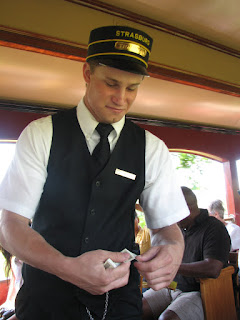 Spotlight:
Spotlight: Hershey, Pennsylvania is sometimes called
Chocolatetown, USA - the
Sweetest Place on Earth. The town was named after its most famous business, the Hershey Chocolate Factory, and has tried to capitalize on that theme with various tourist attractions including: Hershey's Chocolate World, Hersheypark, Hersheypark Stadium, Hersheypark Arena, and the Hershey Museum.
Hershey Chocolate World opened in 1973 to replace the Hershey chocolate plant tour which could no longer accommodate all the visitors. Current attractions include the
Hershey's Chocolate Tour, Create-Your-Own Candy Bar, Hershey Trolley Works, Hershey's Chocolate Tasting Group Experience, and
Hershey's Great Chocolate Factory Mystery in 4D, as well as various gift shops and stores.
Additional Visitor Centers have opened up at other locations around the world including: Chicago, Las Vegas, Niagara Falls, Times Square, Dubai, Singapore, and Shanghai.
Hershey Park opened in 1906 as a leisure park for employees of the Hershey Chocolate Company. Over the years it gradually added rides, including the first steel looping roller coaster on the East Coast. In 1970, the park was expanded and renovated to add new rides, and was renamed Hersheypark. Today, the park contains 110 acres, and hosts
70 rides and attractions including 13 roller coasters and
ZOOAMERICA.
Location: Hershey's Chocolate World and Hersheypark are located at
251 Park Blvd., Hershey, PA.
Cost: Tickets to attractions at
Hershey's Chocolate World can be bought individually or in various combo packages. Individual tickets for attractions range anywhere from $7.95-$15.95 per adult (13+), with discounts for children.
-
Hersheypark tickets currently cost $18.00 (3+) during the Christmas season.
Time: Hershey's Chocolate World opens at 9:00 am daily;
closing times vary depending on month.
Hersheypark hours vary depending on the season. During the summer, plan on spending a
full day or two in Hershey, since there is plenty to do.
Description: The most popular attraction at Hershey Chocolate World is the
Hershey's Chocolate Tour - probably because it is the
only free attraction available. No tickets are needed, and guests get to watch the
transformation of cocoa beans into chocolate bars. Since the factory is no longer open, the ride focuses more on the process used rather than the actual production. As a special bonus, each guest receives a free sample at the end.
Another popular attraction is the
Chocolate Tasting Group Experience. In this experience, visitors learn the proper methods of tasting the various types of chocolates in order to engage all the senses. It was without a doubt the most delicious degree we've earned.
The attraction I was looking forward to the most was the
Create Your Own Candy Bar experience. It allowed us to not only choose the ingredients, but also design the wrapper. It was fun, but I wish that they had more than a few options for each phase: type of chocolate, special ingredient, and wrapper design.
With 13 roller coasters, Hersheypark is
one of my favorite amusement parks I've ever visited. In only 5 hours, we rode about 11 awesome coasters (as thrilling or better than most of the ones at Six Flags Magic Mountain and Disneyland) and enjoyed several other attractions. The park is family friendly, with
rides geared toward every age group. As each person enters the Park, they can measure themselves to see which category they are in. Rides are then posted with the demographics they serve so that guests don't have to wait in a long line only to find out that they can't go on the ride after all. We thoroughly enjoyed the Park and thought that the price was very reasonable - especially compared to the California parks we are accustomed to.
Rating: Hershey's Chocolate World - 4 stars (out of 5)
Hersheypark - 5 stars (out of 5)
Things You Should Know: - Despite being located on the same lot, Hershey Chocolate World and Hersheypark are both
independently owned and operated.
- Ironically, the Hershey Chocolate Factory is now closed, with most of the production taking place overseas. However, the tourist venues remain in Hershey.
- There are several
special themed seasonal events, particularly for Halloween and Christmas.
- You can
save $1.50 per ticket by purchasing your tickets online.
- Other special discounts are available, including a
Hersheypark/Dutch Wonderland combo pack.
- Hersheypark is
open seasonally. It opens on weekends starting in late April; opens daily in June, July, and August; is open on weekends again in September; and open during select weeks/weekends during the holiday season (from Halloween - New Years).
- During the summer, you can buy an all day pass or an
evening pass to Hersheypark at a very reasonable rate. Since we were driving in from the other side of the state in the morning, we spent the afternoon at Hershey's Chocolate World, and the evening at the amusement park. This worked out great since most of the visitors to the park were school groups (early June) and began leaving soon after we went in. We had long lines for our first two rides, but were able to whiz through much shorter lines as the evening wore on.
- In addition to typical rides, Hersheypark has an accompanying water park,
The Boardwalk, with water slides at no additional cost.
-
Parking is $9/vehicle at Hersheypark (veer right). Parking at Hershey Chocolate World (veer left) is free for the first 3 hours, $15 for 3-5 hours, or $30 for an all day pass. There is a tram that can take you from the Hersheypark parking lot to Hershey Chocolate World on days when the park is open.
Nearby: Hershey Gardens, Pennsylvania Farm Show Complex & Expo Center, The National Civil War Museum, Dutch Wonderland























































